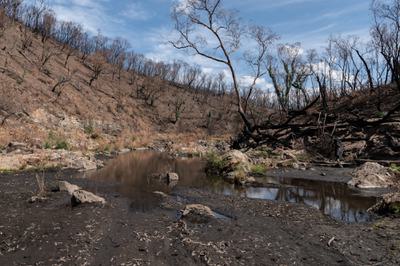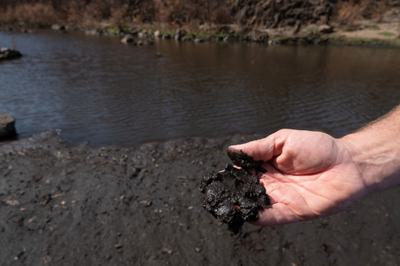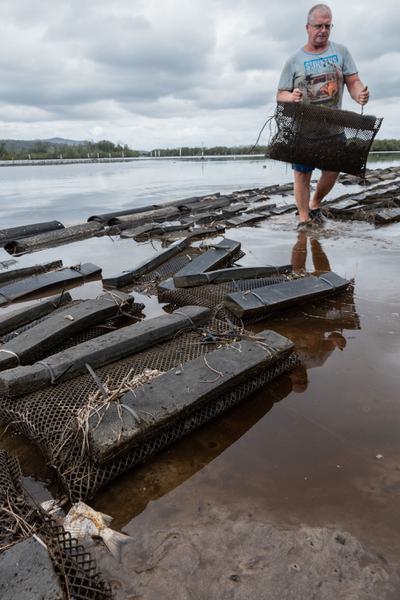Walking through the Bogandyera Nature Reserve, Luke Pearce, a fisheries manager for the Australian state of New South Wales, gestured down a steep hillside and described the scene three days after a wildfire roared through the area on January 11. “There were dead animals all through here,” he said, recalling the carcasses of kangaroos, feral deer, wallabies, wombats, possums, and birds of numerous species strewn across the charred landscape.
Pearce and I were hiking down to a section of the Mannus Creek, a small, high-altitude stream that runs into the Murray River system, Australia’s longest. The Green Valley-Talmalmo fire that tore through this area was one of the many massive bush fires that have made headlines for months as millions of acres of Australia have burned.
As gruesome as the scene had been on land that January day, Pearce’s main concern then, and in the ensuing weeks, has been for a fish, the Macquarie perch. This species, which grows to about 16 inches in length and can live for 25 years, was once abundant and commercially fished throughout the Murray River basin. Today it’s endangered and only found in a handful of sites across southeast Australia, including in this 3.7-mile section of the Mannus Creek. Even before the bush fires, Pearce had been thinking about moving perch out of the creek and into captivity because of declining water quality caused by drought; the fires made that urgent. He managed to net nine perch in the days following the fires — at least some were still alive, he was glad to find — and arranged to return with some colleagues to net more.
“We have never seen that extent of fire-related fish kills anywhere in the world,” says one scientist.
Then, on January 19, thunderstorms dumped large amounts of rain in the Mannus Creek catchment area. It was a relief for many, putting out fires and watering parched cattle paddocks, but the downpours triggered disaster in the creek. When Pearce arrived in Bogandyera Nature Reserve with his fish-netting teams around midday on January 20, they watched in “complete and utter despair” as huge volumes of ashy sediment, like dark, runny mud, came down the stream. “My initial feeling was that everything was going to die,” said Pearce, “I just didn’t know how anything was going to survive in that thick soup.”
Mannus Creek is one of many waterways in Australia that have been inundated with ash and debris following the devastating bush fires this spring and summer, killing fish and other aquatic life and fouling drinking water supplies. In some areas, scientists have mounted unprecedented efforts to create captive populations of endangered fish species threatened by the flood of ash into creeks and rivers.
Luiz Silva and Katie Doyle, freshwater fish scientists at Charles Sturt University, have now documented 14 sites where ash-related fish kills occurred across southeastern Australia in recent months.
A thick layer of fire ash and sediment covers part of Mannus Creek in the Bogandyera Nature Reserve on February 24. Adam Welz for Yale e360
“We have never seen that extent of fire-related fish kills anywhere in the world,” said Silva, adding that he and Doyle documented fish mortality along more than 40 miles of the upper Murray River, even in its large main channel, where pollution would normally be diluted. “People don’t associate fire with water,” he said. “For most people, it seems hard to understand that fire impacts water — and how it impacts water.”
In fact, as the climate warms, droughts become more severe, and the incidence, intensity, and duration of wildfires increases, more rivers and streams worldwide are being adversely affected by ash and debris pouring into aquatic ecosystems in the wake of blazes.
At Mannus Creek, one of the primary impacts of the large pulse of ash was a rapid decline in dissolved oxygen levels in the water. With an electronic probe, Pearce documented oxygen levels dropping from an already-low 7.5 milligrams per liter to 0.06 milligrams per liter on January 20 — virtually zero. “Everything was trying to get out of the creek,” he recalled. “Freshwater shrimp, yabbies [Australian freshwater crayfish], mayfly larvae, freshwater snails — they were all crawling out.”
Pearce even saw dragonfly larvae emerge from the muck and try to molt into their flying, adult forms. They were too immature, and died while he watched. “I found dead tadpoles and Gambusia [small, non-native mosquitofish], which was surprising, because nothing kills Gambusia normally,” he said. “I even saw platypus swimming about at the surface, all stressed, in the middle of the day. You never see them in the middle of the day.”
As the threat to fish from ash became obvious, scientists moved to create captive breeding populations.
Elsewhere in New South Wales, Silva and Doyle found large, dead fish that appeared to have asphyxiated, their gills blackened and clogged with ash. Some had red eyes and appeared to have been “cooked” in fire-heated water. Pulses of ash can cause rapid changes in pH, for example making usually acidic rivers extremely alkaline within a short time, with lethal impacts on river life, said Doyle. Other experts are estimating that hundreds of thousands of fish, at a minimum, have died in southeastern Australia during this fire season.
As the threat to fish from ash has become obvious, scientists and government agencies have moved to create captive breeding populations. The stocky galaxias, a small fish that grows to about 4 inches long, was only described to science in 2014. It is found in just two miles of the small Tantangara Creek in the highlands of Kosciuszko National Park. As enormous fires advanced toward the area in January, University of Canberra fish biologist Mark Lintermans led an effort to catch 142 of the fish, which are now being kept in a government trout hatchery. National park director Mick Pettitt said the Tantangara catchment was severely burned, and park personnel will be assessing the creek and its fish population in weeks to come. Unprecedented numbers of other rare fish species are now being kept at facilities across southeastern Australia.
Oyster farmers who raise shellfish in estuaries along the coast of southeastern Australia are also being hit hard. To protect food safety, they must suspend sales when floods bring polluted water into contact with their shellfish, and the current extreme fire-and-flood situation is triggering shutdowns on many rivers.
Oyster farmer Todd Graham examines his cages in the Clybucca Creek area, near the mouth of the Macleay River, after a surge in ash and acid from upstream caused a massive fish die-off. Adam Welz for Yale e360
About 300 miles north of Kosciuszco, near the mouth of the Macleay River, I visited Todd Graham at his oyster farm in the Clybucca area in mid-February. Large numbers of dead fish were washing up along the banks of the river and being scooped up by pelicans and gulls. Graham told me that fish kills were not unknown in the region, but that “this is probably the worst I’ve seen it.” The water coming in to his area appeared to contain a combination of ash from the fires, sediment from burned forest floors, and acid from upstream wetlands that had been drained by cattle ranchers but now re-flooded. It was so acidic that it began to bleach oyster shells white as we watched.
Penelope Ajani, a marine biologist at the University of Technology Sydney, said that waterborne ash can have a number of effects on estuaries, including shading them and preventing phytoplankton growth, fertilizing them and promoting phytoplankton growth, and coating the estuary floor and organisms with fine sediment. Ash can contain toxic metals, and post-fire flooding can bring toxic fire retardants used in firefighting into estuaries. The full effects of this season’s fires on estuaries may not be known for another decade or two, she said.
The flood of ash into rivers is also affecting drinking water supplies. In January, large parts of the catchment of the Brogo Dam, in the rural Bega Valley in New South Wales, burned. In the second week of February, torrential rains lashed the region, raising the dam’s water level from a drought-lowered 10 percent of normal levels to overflowing in less than 24 hours, and sending enormous volumes of ash and debris into the system. The dam’s water turbidity levels rocketed to more than 100 times the critical control level — the level at which it becomes unsafe to drink — and on February 11 the local government council stopped supplying water from the Brogo dam and river system to 4,000 customers.
Sydney had to temporarily stop using water from a major supply dam after it was inundated with fire ash.
The Australian Defense Force brought in a portable water treatment plant, and water was trucked to residents for two weeks at a cost to the shire council of about $277,000 (USD). The Brogo Dam cleared up sufficiently to come back on line on February 25.
Sydney, Australia’s largest city, had to temporarily stop using water from one of its major supply dams after it was inundated with fire ash, forcing officials to install silt curtains to prevent the spread of ash into reservoirs. Although Sydney’s tap water quality was never endangered, “it was towards the more extreme end of events we were anticipating,” said Tony Webber, media representative of Water New South Wales, which manages the dams.
When I visited Mannus Creek this week with Pearce, the creek’s water was beginning to clear up, though it was still very dirty. Although he has seen a few Macquarie perch in recent days, the deep pools that provide cool water for them to find refuge during hot spells were filled with ash and sediment, as were the gravel beds they need to lay their eggs. No breeding habitat for the species was visible. Pearce said that over time, successive floods would normally flush out the sediment. But with the fire burning so hot in the creek catchment, there was little vegetation regrowth to hold the topsoil. The next rains might dump more sediment in the stream rather than cleaning it.
An 8-inch thick deposit of ash sits on the edge of Alpine Creek in Australia's Kosciuszko National Park on February 23. Adam Welz for Yale e360
As for the plans to breed threatened fish in captivity, this is easier said than done. Pearce told me that female Macquarie perch are difficult to bring into breeding condition in captive facilities. Lintermans pointed out that the stocky galaxias’ breeding biology is virtually unknown. Fisheries managers will have to try to breed it through trial and error, and they might fail.
Doyle said that ash-related fish kills have occurred before, and rivers have naturally flushed out and restored themselves to health over time, but “I think we’ve reached a tipping point now.” In recent years, she said, “fires are now burning so hot that the soils are burning, big trees are burning, everything is burning.” So many trees are dying in river catchments, and so much ash is flowing into aquatic ecosystems, that the former rules may no longer apply.
“We have uncertainty about ecosystem resilience now,” she said. “We don’t know if it [a river] is going to come back after fire. If you’d asked me 10 years ago, I would say, `Yeah, it’s going to come back.’ Now, I’m not sure.”







